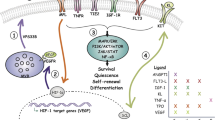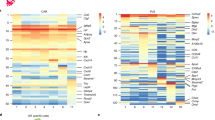Abstract
When long-term bone marrow cultures are treated with Amphotericin B (AB) their haemopoietic stem cells (HSC) cease growing. This is not a toxic effect of the drug because once that is removed, HSC resume clonal growth and, given sufficient time, form as many cells as HSC in untreated cultures. Amphotericin B-evoked inhibition of blood formation is probably mediated by transmembrane communication between HSC and stroma for the following reasons: (1) AB does not stop HSC forming colony-forming units in culture (CFU-c) when HSC are separated from stroma by culturing them on Transwell inserts above the stroma. (2) Conditioned media (CM) from AB-containing or normal long-term cultures (LTC) does not inhibit normal marrow cells forming colonies in semi-solid cultures without stromal underlays. (3) AB itself does not stop bone marrow cells forming colonies in semi-solid cultures nor does it stop stromal cells growing or prejudice their long-term maintenance. (4) Furthermore, growing stromal cells with AB does not alter the number of transcripts they form for cytokines and chemokines to any large extent, including TGF-β 1. We have extensive, though circumstantial, evidence that gap junctions are involved in this communication. AB only stopped the growth of HSC when we blocked intercellular communication via gap junctions (GJIC) (tested by micro-injection of lucifer yellow). Lipophilic compounds that do not affect GJIC had no effect on the growth of HSC. Looking at a series of stromal cell lines from foetal liver and neonatal bone marrow we found that extensive GJIC correlated with stromal support of the late-appearing clones formed by primitive HSC (week 3–5 cobblestone-area forming cells, CAFC). We propose that the proliferation of HSC is regulated via transmembrane communication between stromal and HSC. Our findings support the proposal that gap junctions play a part in this stromal-dependent regulation.
This is a preview of subscription content, access via your institution
Access options
Subscribe to this journal
Receive 12 print issues and online access
$259.00 per year
only $21.58 per issue
Buy this article
- Purchase on Springer Link
- Instant access to full article PDF
Prices may be subject to local taxes which are calculated during checkout
Similar content being viewed by others
Author information
Authors and Affiliations
Rights and permissions
About this article
Cite this article
Rosendaal, M., Mayen, A., de Koning, A. et al. Does transmembrane communication through gap junctions enable stem cells to overcome stromal inhibition?. Leukemia 11, 1281–1289 (1997). https://doi.org/10.1038/sj.leu.2400744
Received:
Accepted:
Issue Date:
DOI: https://doi.org/10.1038/sj.leu.2400744
Keywords
This article is cited by
-
Role of Gap Junctions in Embryonic and Somatic Stem Cells
Stem Cell Reviews (2008)
-
Bone marrow stroma inhibits proliferation and apoptosis in leukemic cells through gap junction-mediated cell communication
Cell Death & Differentiation (2003)
-
Regulatory pathways in blood-forming tissue with particular reference to gap junctional communication
Pathology & Oncology Research (2000)



